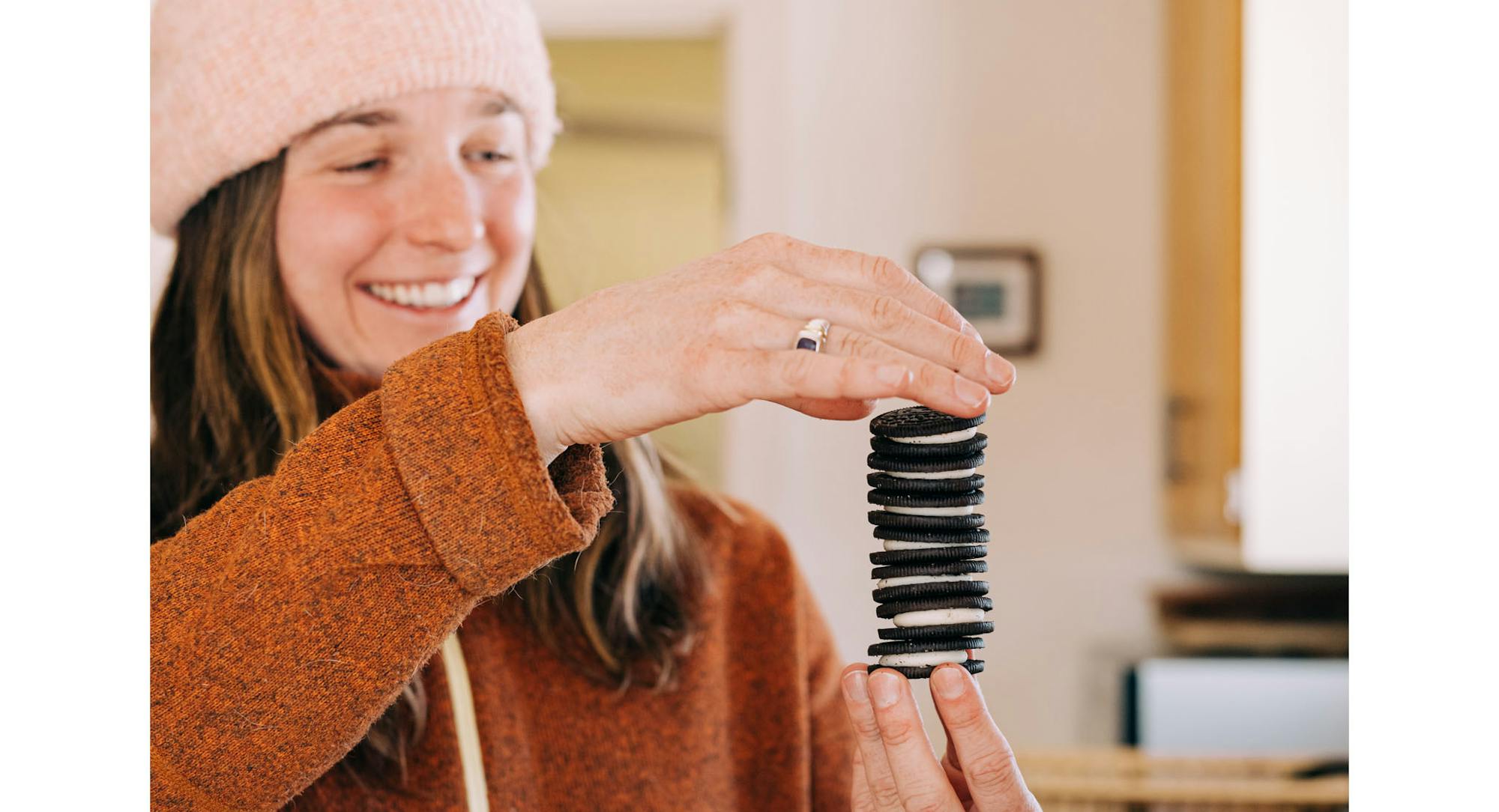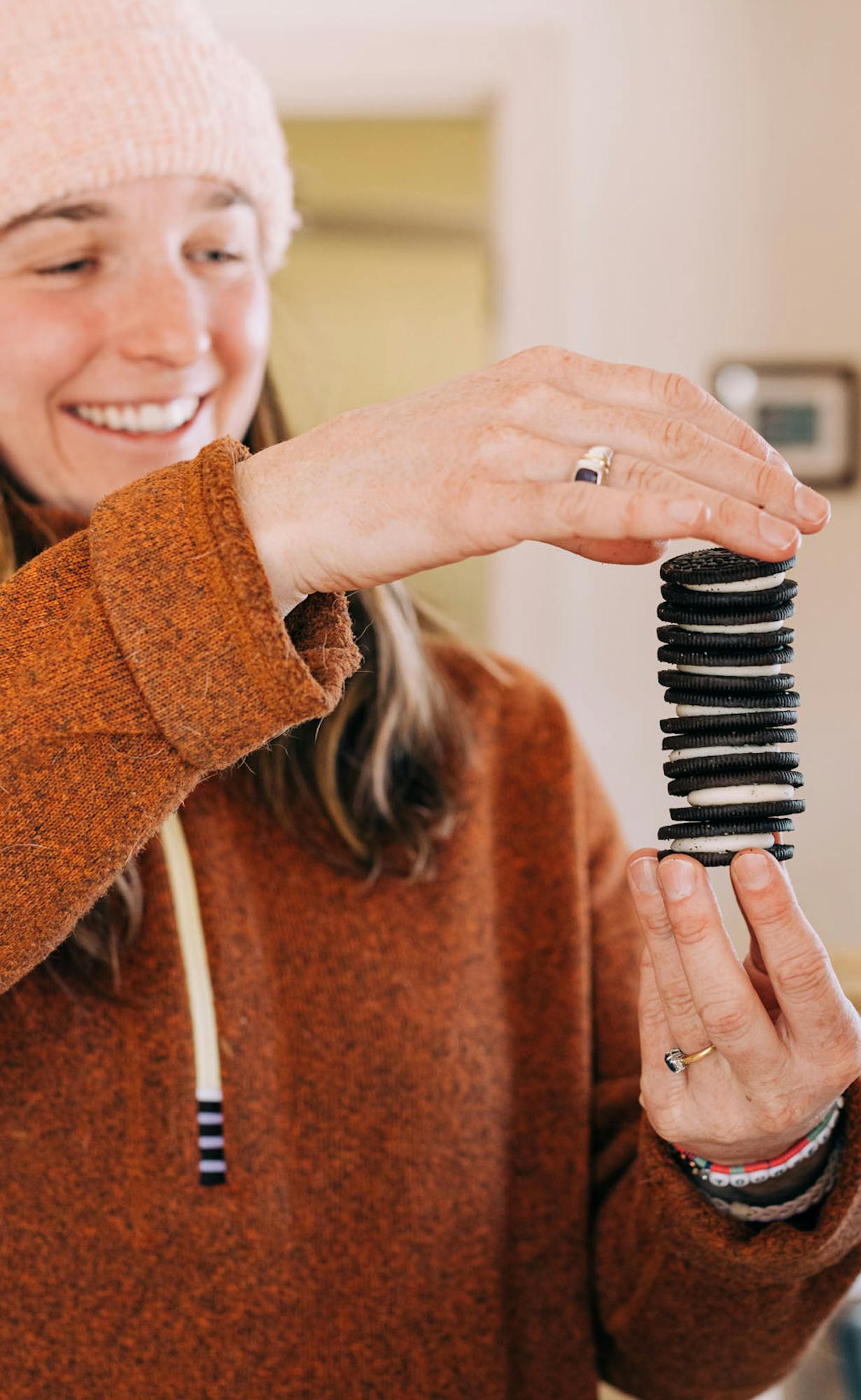Food For Thought
Words by Carolyn Highland, Photos by Katie Cooney
Stio Ambassador Carolyn Highland cuts through the murky morass of nutrition wisdom with the supportive no-nonsense perspective of Registered Dietician Nutritionist, mountain athlete and Teton Valley local Tory Cameron.
I stare at the drawer with my running clothes, paralyzed. Which tank top is baggy enough to hide my not-so-flat stomach? Which shorts are loose enough to not pinch skin over the top of the waistband? My hand flies instinctively to my lower belly, trying to push it in, imagining what it would feel like if there were less, if I were less. How far do I have to run to burn more calories than I ate so I will shrink? Trail running, this thing I love, is sometimes mostly dreading how I’ll feel moving around in clothes that cling to me, how I’ll lose myself in my head while running instead of dialing into the environment around me.
I have spent too many runs in the mountains with my mind running faster than my feet, stressing and criticizing and calculating. I’ve spent too many adventures hoping that the energy I’m expending as I gain thousands of vertical feet will make me smaller. And endurance sports are exhausting enough on their own.
Messages about how our bodies are supposed to look as outdoor athletes are insidious and start winding their way around us early. For women, these messages tell us we have to be smaller, lighter, narrower, not only to look good, but to perform well. For men, it’s stronger, more muscular, more powerful. It’s easy to develop relationships with food and exercise that are no longer about seeking joy in the outdoors or fueling our bodies effectively to that end.
When we engage in disordered relationships with body image, eating and exercise, we lose so much more than weight. We lose the ability to perform at our body’s highest level, we lose the direct line we have with nature when we’re really dialed into our environment on adventures, and we lose our connection to our intuition and our true selves.
Registered Dietitian Nutritionist Tory Cameron has struggled with many of the body image and disordered eating issues that I and others have. As a competitive runner in college, Tory found herself chasing the stereotypical “runner’s body.” When she couldn’t achieve it eating normally, she started restricting calories and entire food groups, looking at exercise as a punishment.
Realizing eventually that this strategy was making her slower, weaker and more miserable, Cameron was inspired to go back to school to be a dietitian and nutritionist. She wanted to support others in changing their relationship with food and body image so they could feel good about themselves and fuel their bodies to get after it in the mountains. While in school, many of Cameron’s paradigms about fueling and exercise shifted away from what diet culture has sold us and toward what really fills and fulfills us.
Based in Victor, Idaho, Cameron sees body image and disordered eating come up frequently for outdoor athletes. Her goal as an RDN is to support her clients in having healthy relationships with their bodies and fueling them properly for success in all their mountain endeavors. Below are some bite-sized pieces of wisdom she wants to share with the outdoor community.
Choose Healthy Thoughts
Society and diet culture provide us with plenty of unhealthy narratives to play over and over in our brains until we feel terrible about ourselves and our bodies. Sometimes we can find ourselves getting in a rut with those negative thought patterns without realizing we have another choice. Finding that moment of pause and realizing we can decide not to engage is where our power lies. Cameron loves supporting her clients with journaling exercises that allow for the recognition of negative thought patterns and creation of new positive patterns.
Focus On How Your Body Feels
We’ve been hit with lots of messages about the purpose of exercise being to make our bodies look a certain way, rather than feel a certain way. Focusing on how getting outside and adventuring makes us feel joy, challenge and awe rather than how it makes us look is the key. If Cameron could pass some words of wisdom to her younger self, she’d say, “I am not my body. I am so much more than what my body looks like. My body is not just an ornament to be gawked at by other people. My body is my vessel of living. So let’s treat it with respect—and also do things that are really badass and fun and that make [us] appreciate it.”
Knowledge Is Power
During her graduate program to become a Registered Dietitian Nutritionist, Cameron remembers a paradigm-shifting moment when she realized that many of the strategies she’d been using had been harmful—things like intermittent fasting and certain restrictive diets are just trendy ways of depriving our bodies of what they need. “Having knowledge is power,” Cameron states. She cites the importance of understanding “what food does and how it supports our activities and our recovery is important.” Making sure you’re getting your nutrition and training advice from trusted, experienced sources is crucial in the age of the unqualified internet health guru. Do your research and bust age-old diet culture myths that are getting in the way of feeling your best outside.
Eat Intuitively*
Intuitive eating was one of Cameron’s biggest discoveries during her master’s studies. She’d spent most of her young adulthood buying into the diet culture pillar that some foods are bad and some foods are good. Cameron points out that “there’s a lot of guilt and shame around eating the wrong thing, or thinking about how to make up for that bad thing you just did. It’s a constant cycle that you get stuck in.” One of her biggest pieces of advice to her clients is to listen to their bodies and eat what they want to eat! She discourages clients from thinking of foods as “good” or “bad,” and from following fad diets that require cutting out entire food groups or fasting.
The asterisk comes in when we are out on multi-hour efforts: “As athletes we can’t always intuitively eat. During our effort or post effort our hunger cues are suppressed, so we need to stick to some sort of consistent schedule.” During endurance sports, it’s nearly impossible to keep up with the calories we are burning without causing gastrointestinal distress, so Cameron recommends trying to make up 40-50% of our calories. “You’re going to be in a deficit, but the goal is to prevent your body from going into a deficit in a way that affects your performance,” she says. I try to eat roughly 300 calories an hour on long efforts and stick to a consistent schedule of eating every 30 minutes. Scheduling in snack breaks ensures I don’t get behind.
Consistency is Key
This brings us to another one of Cameron’s leading values—consistency. Eating on a consistent schedule helps our bodies stay on top of fueling and allows us to obsess over food less. She recommends eating three meals and at least two snacks a day (something every 3-4 hours), plus additional pre, during and post-effort fuel on big days. One of the most common issues Cameron sees with outdoor athletes is not eating enough—both during hard efforts and in the time surrounding them. With busy schedules, Cameron notes, it can be tough to make sure we’re getting enough fuel for big efforts, and this has far-reaching negative effects: “Under-fueling can lead to serious hormonal issues, increase injury, weaken the immune system, and negatively affect mental health,” she shares.
Resting Makes Us Stronger
For most outdoor athletes I know, resting is often harder than running an ultramarathon or skiing a big peak. We spend our lives recreating outdoors because we love it–because it brings us joy and peace and community and stress relief. Resting though, Cameron reminds us, is necessary. “We get weaker when we train. It’s only when we rest that we actually get stronger. If we’re not resting, we’re never going to get stronger.” Cameron recommends making fun plans for our rest days, like having dinner with friends, reading outside, or doing a restful activity like gear tinkering or knitting, so they can be something to look forward to, rather than dread. We also still need to eat on rest days. We may feel less hungry since we’re not exercising, but should still be aiming for our 3 meals and 2 snacks a day—this fuel helps our bodies do the necessary healing for us to get stronger.
When we find ourselves facing a longer period of rest, like recovering from an injury, we have to remember that healing requires fuel just like adventures do. “Your body needs these nutrients and this energy to heal and get you back to what you want to be doing. The more you think negatively and restrict and stress, it’s all going to slow the healing process,” Cameron points out. These periods of extended rest can be ripe for focusing on our deeper inner work related to food and body image, too: “Working on negative thoughts can be done when we’re injured. Often the work we do when we’re injured can be the most powerful, because we’re really in it. Let’s take advantage of this downtime and use it in a positive way.”
Fueling For Performance Is Freeing
I asked Tory what the biggest difference she saw mentally and emotionally in clients who had shifted from eating and exercising in order to be a certain size, to fueling for health and performance. She immediately pointed to freedom. When obsessing over food and body image stops, “it’s the biggest sigh of relief ever. You can use that brain space and that energy to think about other things. To plan a cool adventure.” She also consistently notes the decrease in anxiety, shame and guilt around food for her clients, which can encompass peoples’ whole lives. Cameron says, “fueling yourself appropriately and giving your body what it really needs frees up so much mental space. People seem to enjoy their efforts more, they’re happier, they’re not bonking. They’re like I’ve never enjoyed running, etc. so much.” And isn’t that what we’re really here to do?
Top Stories
Check out all the Top stories
Follow us @stio
See how people are living the mountain life everyday in our gear.








